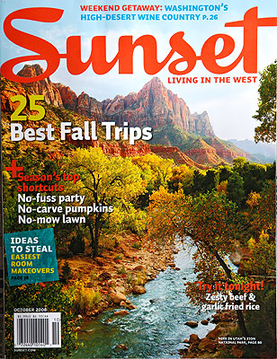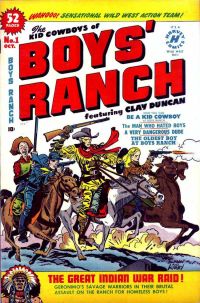
The Western is a genre of fiction set in the American frontier and commonly associated with folk tales of the Western United States, particularly the Southwestern United States, as well as Northern Mexico and Western Canada.

A cowboy is an animal herder who tends cattle on ranches in North America, traditionally on horseback, and often performs a multitude of other ranch-related tasks. The historic American cowboy of the late 19th century arose from the vaquero traditions of northern Mexico and became a figure of special significance and legend. A subtype, called a wrangler, specifically tends the horses used to work cattle. In addition to ranch work, some cowboys work for or participate in rodeos. Cowgirls, first defined as such in the late 19th century, had a less-well documented historical role, but in the modern world work at identical tasks and have obtained considerable respect for their achievements. Cattle handlers in many other parts of the world, particularly South America and Australia, perform work similar to the cowboy.

Wyatt Berry Stapp Earp was an American lawman and gambler in the American West, including Dodge City, Deadwood, and Tombstone. Earp was involved in the famous gunfight at the O.K. Corral, during which lawmen killed three outlaw Cochise County Cowboys. While Wyatt is often depicted as the key figure in the shootout, his brother Virgil was both Deputy U.S. Marshal and Tombstone City Marshal that day and had considerably more experience in law enforcement as a sheriff, constable, and marshal than did Wyatt. Virgil made the decision to enforce a city ordinance prohibiting carrying weapons in town and to disarm the Cowboys. Wyatt was only a temporary assistant marshal to his brother.

Frederic Sackrider Remington was an American painter, illustrator, sculptor, and writer who specialized in the genre of Western American Art. His works are known for depicting the Western United States in the last quarter of the 19th century and featuring such images as cowboys, American Indians, and the US Cavalry.

Tombstone is a 1993 American Western film directed by George P. Cosmatos, written by Kevin Jarre, and starring Kurt Russell and Val Kilmer, with Sam Elliott, Bill Paxton, Powers Boothe, Michael Biehn, and Dana Delany in supporting roles, as well as narration by Robert Mitchum.

Thomas Edwin Mix was an American film actor and the star of many early Western films between 1909 and 1935. He appeared in 291 films, all but nine of which were silent films. He was Hollywood's first Western star and helped define the genre as it emerged in the early days of the cinema.

Stuff is a British consumer electronics magazine published by Kelsey Media.

The New Indian Express is an Indian English-language broadsheet daily newspaper published by the Chennai-based Express Publications. It was founded in 1932 as The Indian Express, under the ownership of Chennai-based P. Varadarajulu Naidu. In 1991, following the death of owner Ramnath Goenka, his family split the group into two companies. Initially, the two groups shared the Indian Express title, as well as editorial and other resources. But on 13 August 1999, the northern editions, headquartered in Mumbai, retained the Indian Express moniker, while the southern editions became The New Indian Express.

John Harris Behan was an American law enforcement officer and politician who served as Sheriff of Cochise County in the Arizona Territory, during the gunfight at the O.K. Corral and was known for his opposition to the Earps. Behan was sheriff of Yavapai County from 1871 to 1873. He was married and had two children, but his wife divorced him, accusing him of consorting with prostitutes. He was elected to the Seventh Arizona Legislative Assembly, representing Yavapai County. In 1881, Wyatt Earp served for about five months as undersheriff of the eastern half of Pima County. When Wyatt resigned, Behan was appointed to fill his place, which included the mining boomtown Tombstone. When Cochise County was formed in February 1881, Behan was appointed as its first sheriff. Tombstone became the new county seat and the location of Behan's office. Sadie Marcus was his mistress, possibly as early as 1875 in Tip Top, Arizona, and certainly from 1880 until she found him in bed with another woman and kicked him out in mid-1881.

Sunset is a lifestyle magazine in the United States. Sunset focuses on homes, cooking, gardening, and travel, with a focus almost exclusively on the Western United States. The magazine is published six times per year by the Sunset Publishing Corporation which was sold by Time Inc. in November 2017 to Regent, a private equity firm led by investor Michael Reinstein. Regent formed the publisher Archetype in 2019 for its media holdings.

The Tombstone Epitaph is a Tombstone, Arizona, monthly publication that covers the history and culture of the Old West. Founded in January 1880, it is the oldest continually published newspaper in Arizona.

Motorcyclist is an American online motorcycling magazine that was published in monthly print format for 107 years, from 1912 to 2017, then moving to six issues per year, until ceasing print publication and becoming online-only in 2019. Since 2013, it has been owned by Bonnier Group and headquartered in Irvine, California.

Frontier Marshal is a 1939 American Western film directed by Allan Dwan and starring Randolph Scott as Wyatt Earp. The film is the second produced by Sol M. Wurtzel based on Stuart N. Lake's biography of Earp Wyatt Earp: Frontier Marshal. An earlier version was Wurtzel's Frontier Marshal, filmed in 1934. The film was remade by John Ford in 1946 as My Darling Clementine, including whole scenes reshot from the 1939 film.

Wyatt Earp: Frontier Marshal (1931) was a best-selling but largely fictional biography of Wyatt Earp written by Stuart N. Lake and published by Houghton Mifflin Company. It was the first biography of Earp, supposedly written with his contributions. It established the Gunfight at the O.K. Corral in the public consciousness and conveyed a mythic story about Wyatt Earp as a fearless lawman in the American Old West. Earp and his wife Josephine Earp tried to control the account, threatening legal action to persuade Lake to exclude Earp's second wife from the book. When the book was published, neither woman was mentioned.

Henry Clay Hooker was a prominent and wealthy rancher during the American Old West who formed the first and what became the largest American ranch in Arizona Territory. After growing up on the east coast, he married and traveled to California, where he established a hardware store in Hangtown. When it burned, he left for Arizona Territory where he partnered with others to supply cattle to the Army and Indian Agencies. When one of the herds stampeded, he found them in a verdant valley. He established the Sierra Bonita Ranch there. It became one of the largest ranches in the Territory and state of Arizona and was held by family members for several generations. He was a personal friend of Wyatt Earp and aided him after the Earp Vendetta Ride.

Boys' Ranch was a six-issue American comic book series created by the veteran writer-artist team of Joe Simon and Jack Kirby for Harvey Comics in 1950. A Western in the then-prevalent "kid gang" vein popularized by such film series as "Our Gang" and "The Dead End Kids", the series starred three adolescents—Dandy, Wabash, and Angel—who operate a ranch that was bequeathed to them, under the adult supervision of frontiersman Clay Duncan. Supporting characters included Palomino Sue, Wee Willie Weehawken, citizens of the town Four Massacres, and various Native Americans, including a fictional version of the real-life Geronimo.

Western comics is a comics genre usually depicting the American Old West frontier and typically set during the late nineteenth century. The term is generally associated with an American comic books genre published from the late 1940s through the 1950s. Western comics of the period typically featured dramatic scripts about cowboys, gunfighters, lawmen, bounty hunters, outlaws, and Native Americans. Accompanying artwork depicted a rural America populated with such iconic images as guns, cowboy hats, vests, horses, saloons, ranches, and deserts, contemporaneous with the setting.

The Cochise County Cowboys is the modern name for a loosely associated group of outlaws living in Pima and Cochise County, Arizona in the late 19th century. The term "cowboy", as opposed to "cowhand," had only begun to come into wider usage during the 1870s. In that place and time, "cowboy" was synonymous with "cattle rustler". Such thieves frequently rode across the border into Mexico and stole cattle from Mexican ranches that they then drove back across the border to sell in the United States. Some modern writers consider them to be an early form of organized crime in America.

The 1976 book I Married Wyatt Earp was published as an authentic, personal memoir of his widow Josephine Earp, but after 23 years as a best-selling non-fiction book, was described as a fraud, creative exercise, and a hoax. Originally published by the respected University of Arizona Press, it is the second best-selling book about western Deputy U.S. Marshal Wyatt Earp ever sold. It was regarded for many years as a factual account that shed considerable light on the life of Wyatt Earp and his brothers in Tombstone, Arizona Territory. It was cited in scholarly works, assigned as classroom work, and used as a source by filmmakers. The book's author, amateur Earp historian Glenn Boyer, said that the retouched image on the cover of a scantily-clad woman was of Josephine in her 20s, and based on his statements, copies of the image were later sold at auction for up to $2,875.

THE FRONTIER TIMES is a popular journal and magazine devoted to history of the American West and Texas. Before it ceased publication, it was published in many locations at Texas.



















